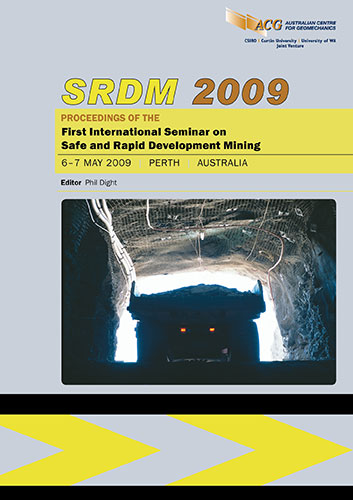Control and measurement of shotcrete thickness

|
Authors: Loncaric, AJ; Loomes, A; Lett, J; Emmi, J Paper is not available for download Contact Us |
DOI https://doi.org/10.36487/ACG_repo/902_09
Cite As:
Loncaric, AJ, Loomes, A, Lett, J & Emmi, J 2009, 'Control and measurement of shotcrete thickness', in PM Dight (ed.), SRDM 2009: Proceedings of the First International Seminar on Safe and Rapid Development Mining, Australian Centre for Geomechanics, Perth, pp. 101-110, https://doi.org/10.36487/ACG_repo/902_09
Abstract:
The Australian mining industry uses approximately 500,000 m3 of shotcrete for ground support per year at a cost of around 12–15% of the total development cost. Shotcrete thickness is a key parameter for ensuring that the lining will meet design specifications and also for controlling usage and cost. The minimum thickness is usually specified and measured as part of the mine quality assurance program. This generally involves using a depth indicator, depth stamp on the wet shotcrete, or drilling and measuring thickness at selected points. These methods collect point data and do not allow for detailed measurements of thickness across the full profile. This paper presents and discusses trials conducted at Ridgeway Mine to measure shotcrete thickness using depth indicators, laser scanners and photogrammetry. The trials demonstrate the benefits of using laser scanning and photogrammetric techniques for obtaining detailed rock profiles and shotcrete thickness profiles. Laser scanning techniques can also be aligned with the mine survey grid enabling rapid and accurate survey of development headings as part of the shotcrete quality assurance/quality control (QA/QC) function.
References:
Faro Technologies (2009) Florida, USA, viewed 13 March 2009,
Riegl Laser Measurement Systems (2009) Horn, Austria, viewed 13 March 2009,
© Copyright 2025, Australian Centre for Geomechanics (ACG), The University of Western Australia. All rights reserved.
View copyright/legal information
Please direct any queries or error reports to repository-acg@uwa.edu.au
View copyright/legal information
Please direct any queries or error reports to repository-acg@uwa.edu.au